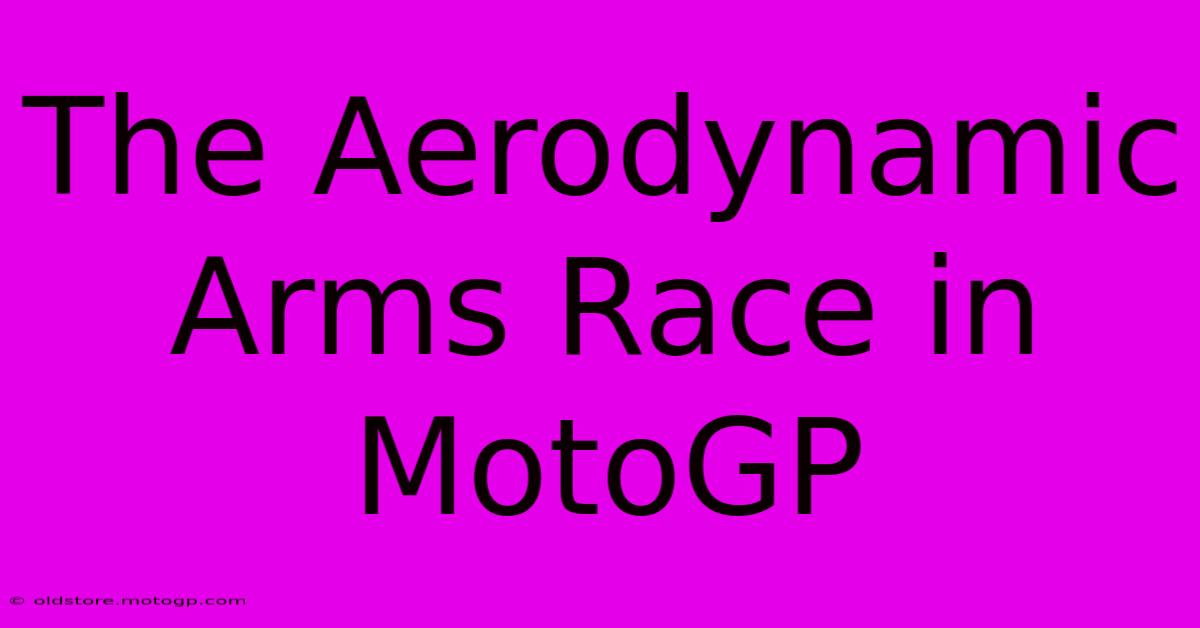The Aerodynamic Arms Race In MotoGP

Table of Contents
The Aerodynamic Arms Race in MotoGP: Wings, Winglets, and the Pursuit of Speed
MotoGP, the pinnacle of motorcycle road racing, is a relentless pursuit of speed and performance. In recent years, a significant battleground has emerged: aerodynamics. This isn't just about streamlining fairings; it's a complex, high-stakes arms race involving sophisticated wings, winglets, and a constant push to manipulate airflow for a crucial edge. This article dives deep into the aerodynamic advancements shaping modern MotoGP, examining the benefits, drawbacks, and the future of this technological battle.
The Science of Speed: Understanding Aerodynamic Downforce
Before we explore the specifics, it's vital to grasp the fundamental principle: downforce. Unlike airplanes that need lift, MotoGP bikes strive for controlled downforce – the force pushing the motorcycle towards the track. This increased grip at high speeds allows for:
- Improved cornering speed: More downforce translates to greater stability and allows riders to lean further into corners without losing traction.
- Enhanced braking performance: Increased grip enhances braking ability, shortening stopping distances and giving riders a competitive advantage.
- Greater stability at high speeds: Downforce keeps the bike planted on the track, even during high-speed straights and unpredictable wind gusts.
The Evolution of Aerodynamic Aids
The early days of MotoGP featured relatively basic fairings. However, the quest for higher speeds and better cornering abilities spurred the development of sophisticated aerodynamic devices:
- Wings: Large, prominent wings, often positioned on the front fairing and sometimes the rear, generate significant downforce. Their design is meticulously optimized to manage airflow, minimizing drag while maximizing downforce.
- Winglets: Smaller, wing-like structures, usually located on the fairing, further enhance downforce and stability. Their placement and angle are crucial to their effectiveness, often tailored to specific tracks and riding styles.
- Streamlining and Fairing Design: The overall shape and design of the fairing play a crucial role. Even minor adjustments can impact airflow and create noticeable performance gains. Computational fluid dynamics (CFD) simulations are crucial in this iterative design process.
The Arms Race: Manufacturers Pushing the Boundaries
The constant push for aerodynamic advantage has led to a fierce competition amongst manufacturers. Each team employs aerodynamic experts and invests heavily in wind tunnel testing and CFD analysis to refine their designs. This continuous evolution results in:
- More complex designs: Each new season sees increasingly intricate wing and winglet configurations, with designs constantly being tweaked and refined.
- Increased performance: The aerodynamic gains translate to tangible improvements in lap times, often deciding the difference between victory and defeat.
- Safety concerns: The increasing reliance on aerodynamic aids has raised concerns about safety, particularly regarding potential instability at high speeds or during crashes.
The Future of Aerodynamics in MotoGP
The future of MotoGP aerodynamics promises even more sophisticated solutions. We can expect:
- Further miniaturization: Smaller, more integrated aerodynamic devices will likely emerge, potentially hidden within the fairing to minimize drag.
- Adaptive aerodynamics: Systems that adjust wing angles and shapes based on speed and track conditions could offer significant performance benefits.
- More stringent regulations: Governing bodies may introduce regulations to manage the arms race, ensuring fairness and addressing safety concerns.
Conclusion:
The aerodynamic arms race in MotoGP is a fascinating technological battle, showcasing the constant drive for innovation and performance. The sophisticated aerodynamic aids employed by teams dramatically impact racing performance, creating a thrilling and unpredictable spectacle for fans worldwide. As technology advances, we can anticipate even more impressive advancements in the years to come. The pursuit of the perfect balance between downforce and drag will continue to define the future of MotoGP.

Thank you for visiting our website wich cover about The Aerodynamic Arms Race In MotoGP. We hope the information provided has been useful to you. Feel free to contact us if you have any questions or need further assistance. See you next time and dont miss to bookmark.
Featured Posts
-
Austin Gp Concert What To Expect
Feb 18, 2025
-
The Best Way To Experience Cota General Admission
Feb 18, 2025
-
Moto 3 Bikes The Ultimate Guide To Moto 3 Bike Upgrades
Feb 18, 2025
-
Get Ready To Roar F1 Austin Concert Extravaganza
Feb 18, 2025
-
Accident Moto Gp The Role Of The Race Marshal
Feb 18, 2025
